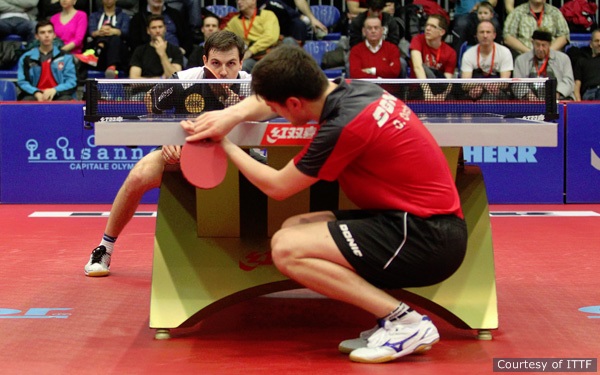
Table tennis coaches (myself included) often favour teaching a modern topspin game. We coach a conventional playing style, such as service from the backhand corner, playing forehands on ¾ of the table, playing topspin strokes as often as possible, attack, attack attack! If you watch any junior who has been coached, they will almost certainly play in this way.
And whilst this is the dominant (and most successful) style of table tennis at present, it’s not the only way to play. Having an unconventional playing style can be effective too. Dimitrij Ovtcharov (world ranked 6) often serves from the forehand corner and favours backhand attacks. Vladimir Samsonov (world ranked 8) serves from the centre and uses the block shot much more than most. Joo Sae-hyuk (world ranked 15) is a defensive player, frustrating opponents with heavy backspin chops.
The two most successful British players of the past 30 years were both unconventional. Desmond Douglas (reached 7 in world rankings) played very close to the table, used the block shot a lot and often prefered drive shots to topspin. Matthew Syed (reached 24 in world rankings) was a defender, who was happy to play 10 feet back from the table.
Having an unconventional playing style can bring success. But why is this?
Quite simply, the unconventional player has the benefit of the surprise factor. They present their opponent with spins, angles, body movements and match tactics they’re not used to.
In a competitive match, there isn’t a great deal of time to work out what the unconventional player is doing and how to counter their unconventional play. By the time a player has worked it out, it may be too late.
And because they are a rare breed, there may not be many (if any) opportunities to practice against their particular unconventional style. If you can’t practice, you can’t improve.
I have witnessed this first hand with my team mate Yordan. He stands with his right leg forward to favour his backhand, serves from the middle of the table with a long service motion, pushes and blocks to great effect and has a devastating backhand drive for any balls which are slightly high.
I once thought he needed to change his entire game, to become more conventional, because that’s the ‘best’ way to play table tennis. But why? It’s his unconventional style which causes opponents so many problems. Higher ranked players struggle against him and juniors are completely flummoxed. They’re not used to his playing style. They haven’t developed tactics to beat him.
I have the benefit of playing with Yordan fairly regularly, so I have got used to his style. But because he’s mastered his unconventionality, it’s still hard work (he wins half, I win half). No one else I know plays like him. That’s the advantage he brings to every match.
Of course, an unconventional playing style usually has limitations. For example, if you play with a backhand stance (as Yordan does), it can be tricky to play strong forehand strokes. But this may be ok as long as you’re aware of the limitation. You can compensate by playing more from the centre of the table (to maximise backhand space), playing to positions which increase the chance of the ball coming to the backhand side and improving footwork to better attack balls which do come to the forehand.
And sometimes the unconventional becomes conventional, for example the backhand flick from the forehand side. This was considered very unconventional at first. But guess what? It worked! And now all the top players use this shot. It has become the norm.
It is possible to reach a very high level with an unconventional playing style, as demonstrated by the list of players mentioned at the beginning of the blog post. And it would be fairly boring if everyone had the same playing style. Unconventional styles keeps table tennis interesting and provides players with new challenges to overcome.
So if you do have an unconventional playing style, don’t feel you have to change your game to fit in with the norm. An unconventional playing style may not be the most efficient way of playing table tennis, but it can be very effective.
